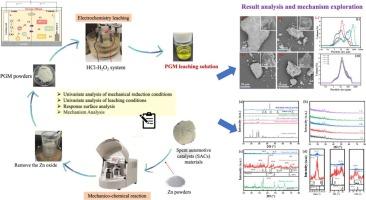从废汽车催化剂中回收铂族金属的电冶金和机械化学方法
IF 4.8
2区 材料科学
Q1 METALLURGY & METALLURGICAL ENGINEERING
引用次数: 0
摘要
为了应对资源日益短缺的情况,回收废物的做法已成为可持续发展的关键战略。在本研究中,介绍了一种创新的方法,以提高从废汽车催化剂(SACs)中回收铂族金属(PGMs),涉及集成机械化学还原预处理和电化学浸出的集成电化学冶金工艺。深入探讨了机械化学球磨参数和电化学浸出条件对PGM回收率的影响,得到了有意义的结果。其中,Zn是促进高活性PGM颗粒生成、促进磨削、减少铂族金属氧化物以及与PGM合金的关键催化剂。机械化学还原预处理使Pd、Pt和Rh的表观溶解活化能分别从40.1 kJ/mol、43.7 kJ/mol和62.5 kJ/mol降低到13.2 kJ/mol、17.5 kJ/mol和22.1 kJ/mol。通过正交试验优化后,Pd、Pt和Rh的浸出效率分别达到了98.5%、98.1%和93.3%。本研究揭示了一种高效实用的从sac中浸出pgm的方法,有利于资源的可持续管理。本文章由计算机程序翻译,如有差异,请以英文原文为准。

An electrometallurgical and mechanochemical approach for the recovery of platinum group metals from spent automotive catalysts
In response to the escalating scarcity of resources, the practice of recycling waste has emerged as a pivotal strategy for sustainable development. In the present study, an innovative method is introduced to enhance the recovery of platinum group metals (PGMs) from spent automotive catalysts (SACs), involving an integrated electrochemical metallurgy process integrating mechanochemical reduction pretreatment and electrochemical leaching. An in-depth exploration on the influences of mechanochemical ball-milling parameters and electrochemical leaching conditions on PGM recovery yielded insightful results. Notably, Zn emerges as a key catalyst to promote the generation of highly reactive PGM particles, facilitate grinding, reduce platinum group metal oxides, and alloy with PGMs. The mechanochemical reduction pretreatment significantly reduces the apparent dissolution activation energies of Pd, Pt, and Rh from 40.1 kJ/mol, 43.7 kJ/mol, and 62.5 kJ/mol to 13.2 kJ/mol, 17.5 kJ/mol, and 22.1 kJ/mol, respectively. Following optimization through orthogonal experiments, the leaching efficiencies of Pd, Pt, and Rh reached exceptional levels: 98.5 %, 98.1 %, and 93.3 %, respectively. This study unveils a highly efficient and practical approach for leaching PGMs from SACs, which is conducive to sustainable resource management.
求助全文
通过发布文献求助,成功后即可免费获取论文全文。
去求助
来源期刊

Hydrometallurgy
工程技术-冶金工程
CiteScore
9.50
自引率
6.40%
发文量
144
审稿时长
3.4 months
期刊介绍:
Hydrometallurgy aims to compile studies on novel processes, process design, chemistry, modelling, control, economics and interfaces between unit operations, and to provide a forum for discussions on case histories and operational difficulties.
Topics covered include: leaching of metal values by chemical reagents or bacterial action at ambient or elevated pressures and temperatures; separation of solids from leach liquors; removal of impurities and recovery of metal values by precipitation, ion exchange, solvent extraction, gaseous reduction, cementation, electro-winning and electro-refining; pre-treatment of ores by roasting or chemical treatments such as halogenation or reduction; recycling of reagents and treatment of effluents.
 求助内容:
求助内容: 应助结果提醒方式:
应助结果提醒方式:


